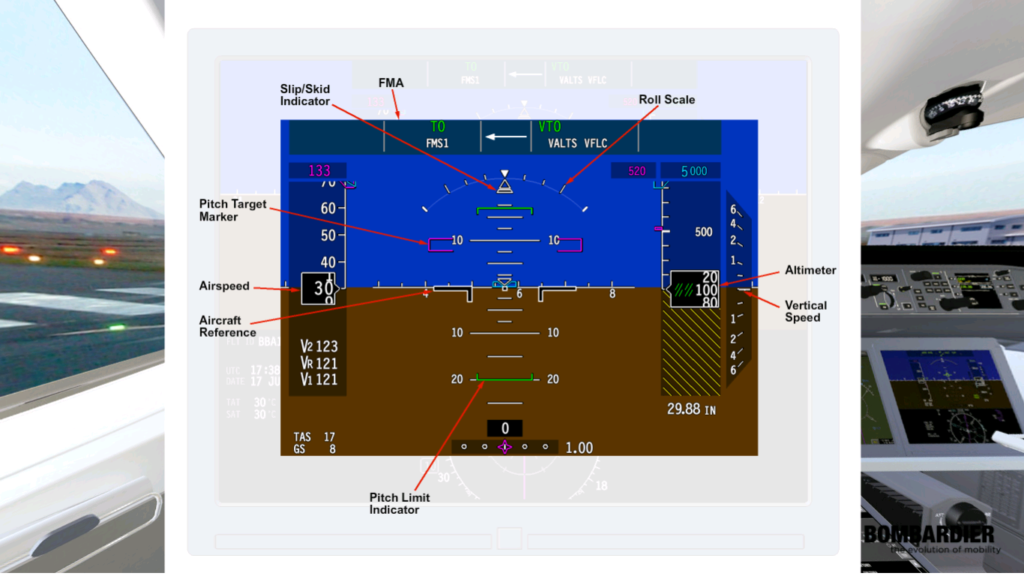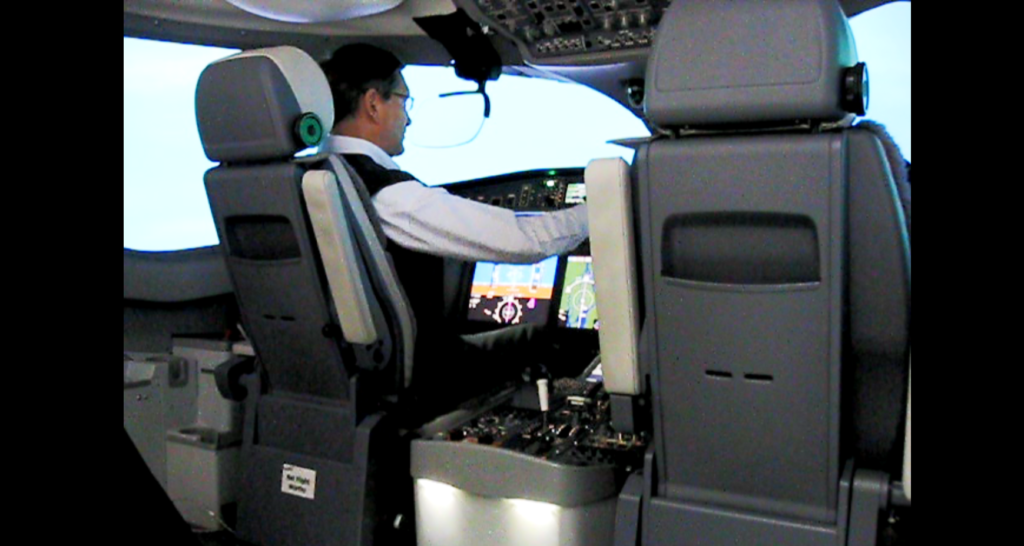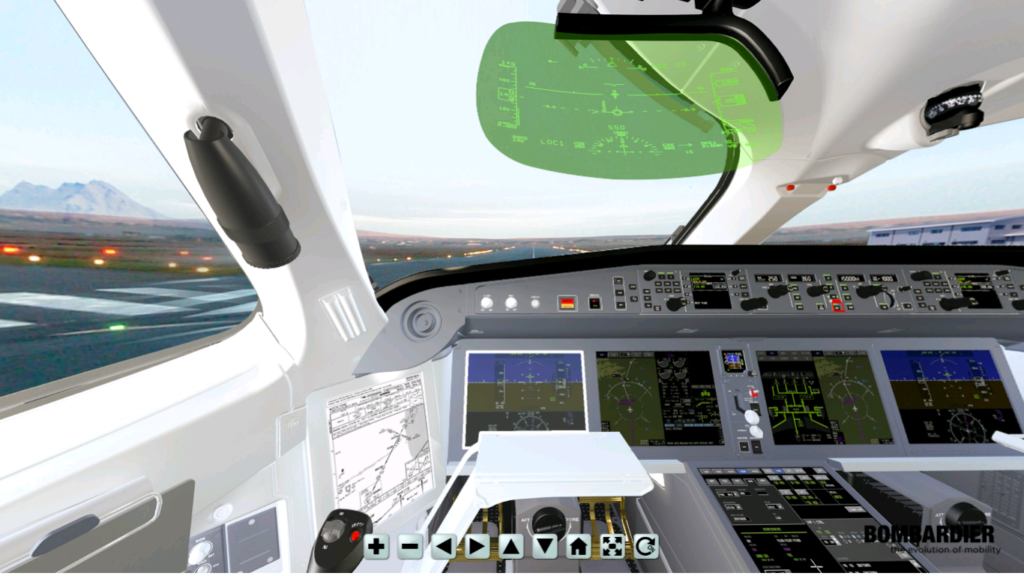Leeham News and Analysis
There's more to real news than a news release.
 Leeham News and Analysis
Leeham News and Analysis
- GE testing of giant GE9X engine aims for maturity at entry into service June 30, 2025
- Bjorn’s Corner: Air Transport’s route to 2050. Part 28. June 27, 2025
- Parent agency, FAA often at odds as politics outweighs safety June 26, 2025
- Electric Flight and the Ugly Duckling June 25, 2025
- Engine makers tout “Plan A” but have “Plan B” backups in R&D June 23, 2025
Preparing to fly the CSeries
By Bjorn Fehrm
November 03, 2016, ©. Leeham Co: We were invited to Bombardier (BBD) in Montreal last week for a series of special events.
The visit had three purposes: attend the roll out of airBaltic’s CS300 (reported here), prepare to fly the CSeries in the simulator and finally to test fly the aircraft at BBD’s Wichita (KS) test flight facility.
It was mid-October when the chance came to test fly the CSeries. The ideal time would be October 24-26, just before the test aircraft, FTV8 (the CS300 route proving aircraft), would take off for the Airshow China in Zhuhai.
The testing would have three parts:
- Study the aircraft via BBD’s online training program.
- Fly the aircraft in the CSeries simulator in Mirabel, close to Montreal.
- Fly FTV8 from BBD’s test flight station in Wichita (KS).
Learning the CSeries
Before you fly a new aircraft, you must learn the peculiarities of its systems and cockpit. The actual flying is highly standardized for airliners. The trick is to learn how the avionics work, what flight laws and protection schemes are implemented and how to master the “knobbery” for its systems.
The last can sound trivial but is often the most difficult. Test flights are quickly done and one cannot re-do a landing because one could not engage the thrust reversers because the throttles have a different reverse thrust schema than the last aircraft one flew.
Two hours training in the CSeries simulator was well spent. There, one has the time and ambience to test all knobs/handles and their intrinsics, Figure 1.
Before flying, one must learn the aircraft. I had a good idea of the systems and performance of the CS300 after implementing it in our performance model. Now I needed to learn the displays, cockpit controls and avionics in detail.
Bombardier has established an online training portal for all its aircraft, Figure 2.
The site simplified preparations. There is one’s own account with all manuals, iPad apps, etc. There are also on-line eLearning tests for checking one’s skills. One of the tools is a virtual 3D cockpit where panels and displays pop-up when touched, Figure 3.
Figure 4 shows the Primary Flight Display where we have asked the top part to be explained.

Figure 4. The Primary Flight Display (PFD) top part explained in the virtual cockpit tool. Source: BBD.
The top part of the PFD is the FMA, which stands for Flight Mode Annunciator, i.e., what Autopilot or Auto throttle modes are armed (White), active (Cyan) or FMS controlled (Magenta).
The portal made the study of the aircraft easy. It was just a matter of identifying the appropriate manual PDF (in total about four times the ones visible in Figure 2) and browsing to the right parts.
Had it been for real and should I check out for the aircraft, I could also test my learning level with the on-line eLearning courses in the lower part of Figure 2.
Simulator flying
The simulator session was extra interesting for me as I could assess the take-off and landing procedures for the CSeries. Because I didn’t have an active Airline Transport Pilot License (ATPL), my test flying later in the week would not include takeoff and landings, a restriction imposed by Transport Canada rules.
I was fine with that. I did normal and single engine takeoffs and landings in the simulator which was later repeated in the air to check for any differences. In the simulator, I could also fly with the CSeries Head Up Display (HUD), something that our test aircraft, FTV8, did not have.
CSeries flight laws
As I prepared to fly the CS300, the CSeries chief test pilot, Chuck Ellis, explained the philosophy behind the chosen flight laws for the aircraft. The Fly-By-Wire (FBW) is implemented with what is called C*U flight laws in the pitch axis. This is like the Boeing 777 and 787 implementations.
The aircraft does not auto-trim away the pitch forces on the side-stick as speed changes; this is for the pilot to do. This principle is called “trim for speed” and it makes the aircraft behave like a normal, non-fly-by-wire aircraft, in pitch.
Ellis explains: “The time when a pilot will revert to manual control of the aircraft is when things are not as expected. He can then be highly stressed and there is a high risk that he reverts to what he once learned in basic flight training. A C*U pitch mode will then give him that well-known feeling, that he knows what the aircraft is doing. It’s intuitive for pilots to feel in the stick if the aircraft is under or over trimmed speed”.
Ellis continues: “We therefore decided to modify the C* pitch law initiated in the Airbus A320 (which commands pitch rate at low speed and pitch load factor at high speed with constant auto-trimming) with the trim for speed principle. It means an aircraft which is flying to fast will raise its nose and one which is flying to slow will dip the nose to regain trimmed speed”.
Flight laws for roll are the classical roll rate per stick movement and for yaw is yaw angle as a function of rudder displacement.
Cockpit layout and avionics
The CSeries is a clean sheet aircraft and it shows in the cockpit layout and handling of its avionics. Cockpit layout is very clean and logical. The glare shield has a Control and radio Tuning Panel (CTP) which makes radio/nav tuning but also many other tasks like setting of landing minima a “looking out” operation, Figure 5.
The Flight Management System (FMS) is a modern full page graphical design with Tiles and Tabs, Figure 6. It has a logical “Phase of Flight” structure. Control is via trackball and keys unit, besides the throttles.
The throttles are back-driven like on most FBW aircraft. It means one can rest the hand on the throttles and feel the auto throttle working.
Sidesticks are passive with two spring rates. One for normal operation and a final harder spring rate for emergency operation. The felt stops are called “soft stop” and “hard stop”. At the hard stop, there is also a stick shaker that activates.
Protections in action
We will look closer how these two working areas of the sticks are combined with soft and hard protection schemes in the next article, which describe the actual flying of the CSeries out of the International airport in Wichita. We shot some videos from my test flight which shows the protections in action. What might sound complicated is in practice logical and natural, soft and hard stops makes sense.
Share this:
- Click to print (Opens in new window) Print
- Click to email a link to a friend (Opens in new window) Email
- Click to share on X (Opens in new window) X
- Click to share on Pinterest (Opens in new window) Pinterest
- Click to share on Facebook (Opens in new window) Facebook
- Click to share on WhatsApp (Opens in new window) WhatsApp
- Click to share on LinkedIn (Opens in new window) LinkedIn
- Click to share on Tumblr (Opens in new window) Tumblr
- Click to share on Reddit (Opens in new window) Reddit
Related
Category: Bombardier, CSeries, Pratt & Whitney, Rockwell Collins
Tags: Avionics, Bombardier, CS300, CSeries, flight test







Not related to the flying but I recently realized that the hull is almost as big as the 737, while the cabin width is like some 40cm smaller. Why does the CSeries have so much thicker walls?
Both have 0.11m thick cabin walls, you are probably looking at the cabin width at the floor level.
I have the following values from the airport planning manuals:
Hull Cabin Floor Wall
CSeries 3.70m 3.28m 3.10m 22cm (3.7 – 3.28)/2
737 3.76m 3.54m ? 11cm
Are the values I have from the Bombardier (APP) manual wrong or not up to date?
As I read it the Bombardier specs show the total width of walls (22cm/2), while the 737 states one wall (11cm)
Sorry for the format, the added spaces got removed.
The difference between outer diameter (3.7m) and cabin width at shoulder level (3.28m) is 42cm for the CSeries. So that makes it 21cm per wall compared to the 11cm for the 737.
BBD give you the fuselage height as 3.7m, APM page 6. It’s a double bubble design with a width of 3.5m, the walls are then the usual 11cm.
Are the RH and LH stick interconnected in any way?
No, they sum the inputs electrically if both sticks are moved. There is also a warning of dual input and there are buttons to claim priority, very much like other passive stick FBW aircraft.
Bjorn, presumably “FTV8” is Flght Test Vehicle 8? And it’s the route proving vehicle, as you have noted. Well then, isn’t it strange that it doesn’t have the HUD installed? Haven’t HUDs become “standard” on new aircraft? (I see them on nearly all B787 cockpit pictures, for example.) It also raises an interesting question about certification of same, if the route proving aircraft doesn’t have one!
A right old saga going on with St Helens unusable new $300million airport. The intended B737 can’t land oweing the excessive wind shear. Smaller aircraft including Bae RJ have been suggested.Would the C series be any good for this task?
What a boondoggle that airport has become…
St Helena .
“An Avro RJ100 jet aircraft, operated by Tronos Jet Maintenance and carrying two Atlantic Star Airlines personnel, successfully conducted a technical stop at St Helena Airport on Friday 21 October 2016 – as part of a delivery flight to a customer in Chile…… a smooth landing from the south on Runway 02 and, after disembarking a few passengers, took off, completed a circuit, and performed an equally smooth landing from the north on Runway 20. The aircraft departed St Helena on Saturday afternoon ..”
http://www.sainthelenaaccess.com/news/
The plane was being delivered from Switzerland to Chile- a most unusual route -but I think it was to test its suitability for St Helena, with pilots familiar with the Faroe Is!
Napoleon was much interested in the weather while on the Island, but he was very interested in scientific things and after Waterloo had wanted to be exiled to the US where he could pursue a scientific career.
Bjorn, you said you have flown the flight simulator in Mirabel, was this the engineering simulator (ESIM) adjacent to CIASTA? I expected you instead to fly in the CAE simulator in Saint-Laurent. Which simulator is normally used by customer pilots, is it the ESIM or CAE’s?
It was the ESIM. The CAE training simulator has movement as well but as I’ve written before a good visual systems makes the impression real enough. I guess it was more convenient, 2 hours Sim time is long and was perhaps not so easy to get in the CAE one. I take more fixed Sim time than shorter in a moving one.
I guess both are used, ESIM of course for development like checking out new avionics software releases but also for familiarization like for me. The CAE installation then for formal training and check out flights. You need both.
Bjorn:
I am up for adoption! I would love to be part of your family.
I am self supporting and only require a chance to fly simulators and aircraft.
Don’t feed him Bjorn, he will never leave… 🙂
Ahh, but I don’t cry, keep you up at night and am very grateful!
I was reading AV week write-up on the newest Gulfstream
To me the control logic is starting to come together in a common sense way.
Throttle are driven (I never got the back driven thing, they go back and forth!) Driven, linked etc.
Side stick is linked *(back driven, hmmm) and has harder limits as you get to the edge.
I drove an R80 Euk that had the bump and steer thing, I did it fine, I didn’t like it.
My take is all controls should work like a mechanically linked controls aircraft that we all learned on.
There should also be a standards that they all operate exactly alike by the same control laws.
At one time the French had a throttle design you pulled back to add power. Now its forward (other than helicopters) and they found to the sad regret that the V-22 used the pull back and lost an aircraft . That was changed.
Each mfg should not be putting out their take.
The end result can be and has been people moving form one mfg to the other do not really get it. You tend to repeat your first training.
The Apollo capsule simulator had been conceived by North American to push to go up and to pull to go down. Frank Borman made sure this was changed before going into production. That is one of the reasons why it is important that pilots, technicians, flight attendants, and various other players, be part of the design process.
Great article Bjorn, with great explanation from Chuck Ellis on the implication of C*U Control Law. Have myself been involved in engineering aircraft’s aerodynamic model.
Are you planning to visit Bombardier soon, back at ESIM ?
Hi Ramzi,
thanks. Yes, it was a very good discussion with Chuck and team at the test group. It was over beer and burger at the local pilot hang out in Wichita, as it should. I enjoyed Mirabel and ESIM, Mark Elliott showed me around. It will take some time before I can get into the ESIM again I’m afraid, enjoyed it!
Stay tuned for the article tomorrow on the actual flying of the CSeries with Andy Litavnik and team in Wichita.